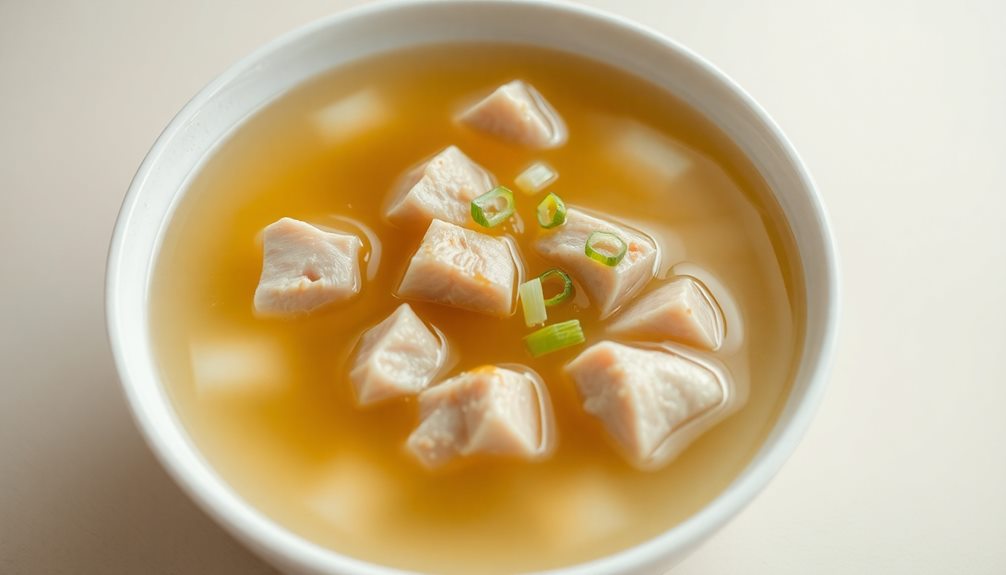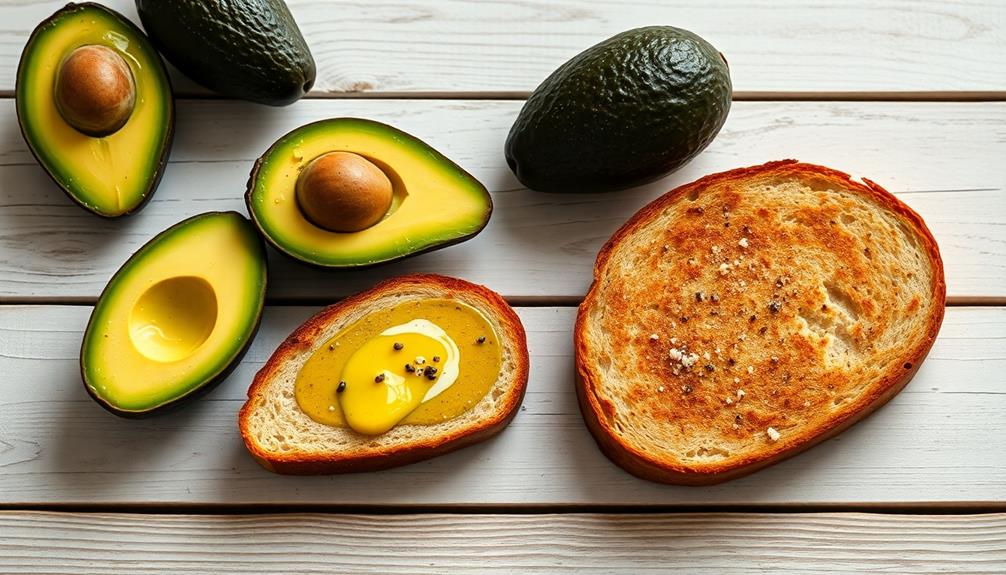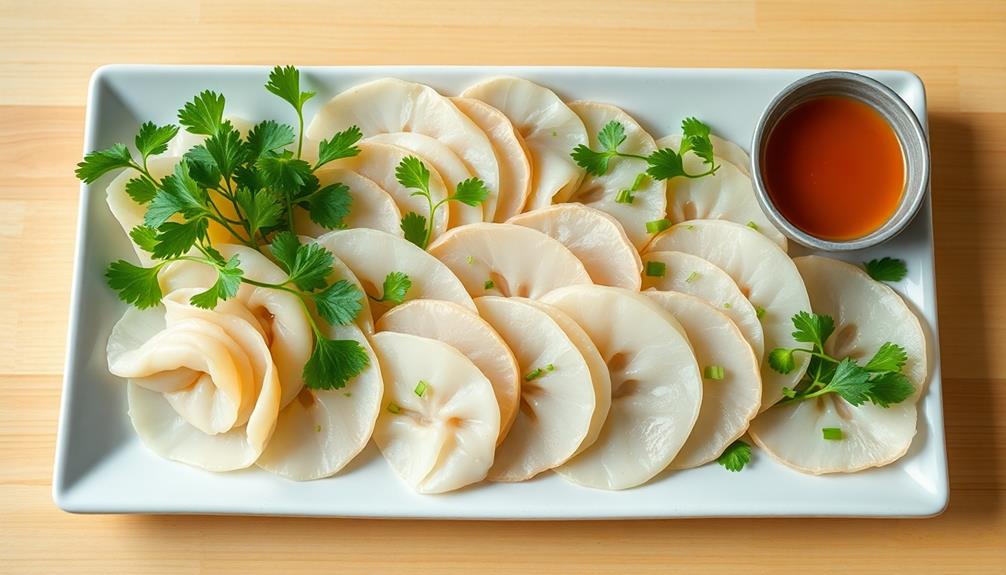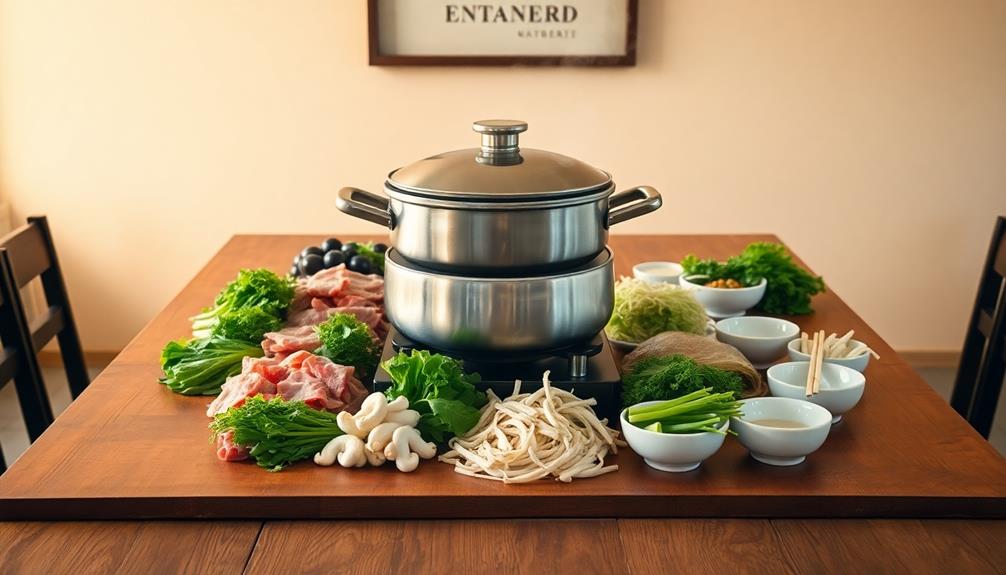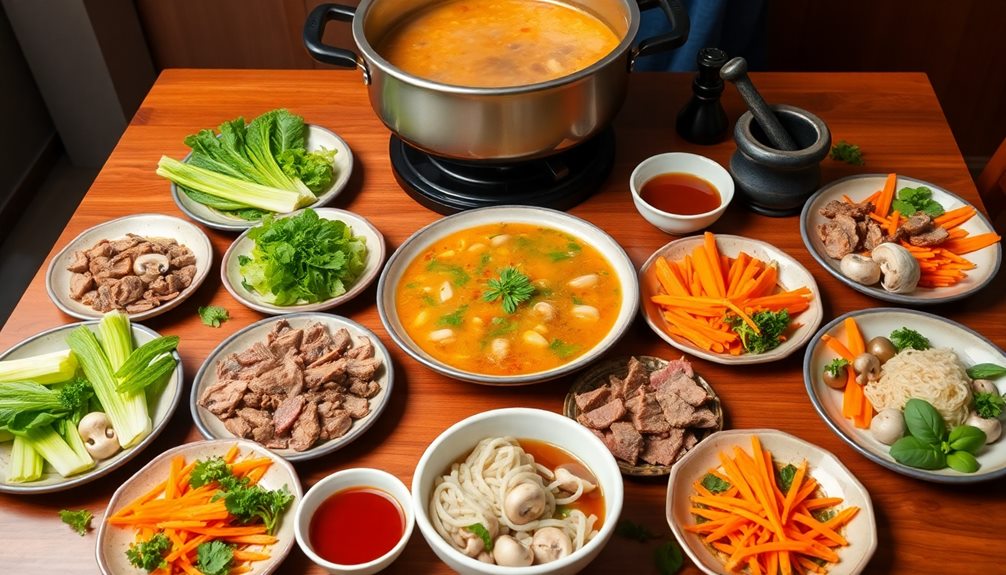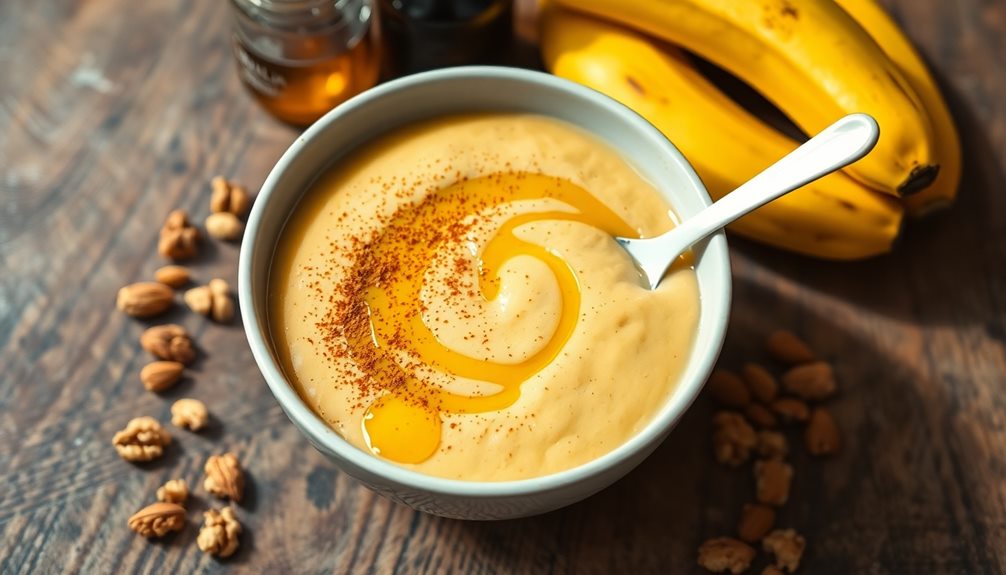Thit Dong, a cherished Vietnamese dish rooted in rich culinary traditions, shines at festive celebrations. This savory delicacy blends the tender texture of pork with a captivating jellied exterior. The journey begins by simmering pork hocks until a flavorful broth emerges. Softened gelatin is then seamlessly incorporated, transforming the mixture into a velvety, gelled delight. Chilled and sliced, Thit Dong's harmonious flavors and contrasting textures enchant the senses. Crunchy peanuts and aromatic herbs elevate this cultural gem, showcasing the artistry of Vietnamese cuisine. There's more to discover about this remarkable dish that's sure to captivate your taste buds.
Key Takeaways
- Thit Dong is a traditional Vietnamese dish with origins rooted in the country's rich culinary heritage, often served during celebrations and special occasions.
- The dish involves simmering pork trotters, tendons, and skin to create a gelatinous broth, which is then combined with bloomed and strained gelatin.
- The gelatin-enriched broth is poured into molds and chilled, resulting in a firm, jelly-like texture that contrasts with the tender pork inside.
- Thit Dong is typically served with accompaniments like pickled vegetables and fresh herbs to provide a flavor contrast to the savory-sweet dish.
- The meticulous preparation of Thit Dong showcases the Vietnamese culinary artistry and represents a vibrant aspect of the country's cultural heritage.
History

The origins of Vietnamese jellied pork can be traced back to the country's rich culinary heritage, where traditional techniques and local ingredients have long been woven into the fabric of everyday meals.
This beloved dish, known as Thịt Đông, has been a staple in Vietnamese celebrations and special occasions for generations.
Thịt Đông's history is deeply rooted in the country's diverse cultural influences, blending Chinese and French techniques with native Vietnamese flavors.
The process of making this savory jelly involves simmering pork trotters, tendons, and skin until the collagen breaks down, creating a rich, gelatinous broth.
This broth is then poured into molds and chilled, resulting in a firm, translucent jelly that's both delicate and packed with umami flavor.
The serving of Thịt Đông is often accompanied by an array of accompaniments, such as pickled vegetables, soy sauce, and fresh herbs, allowing diners to customize their experience and savor the contrasting textures and flavors.
Cooking Steps
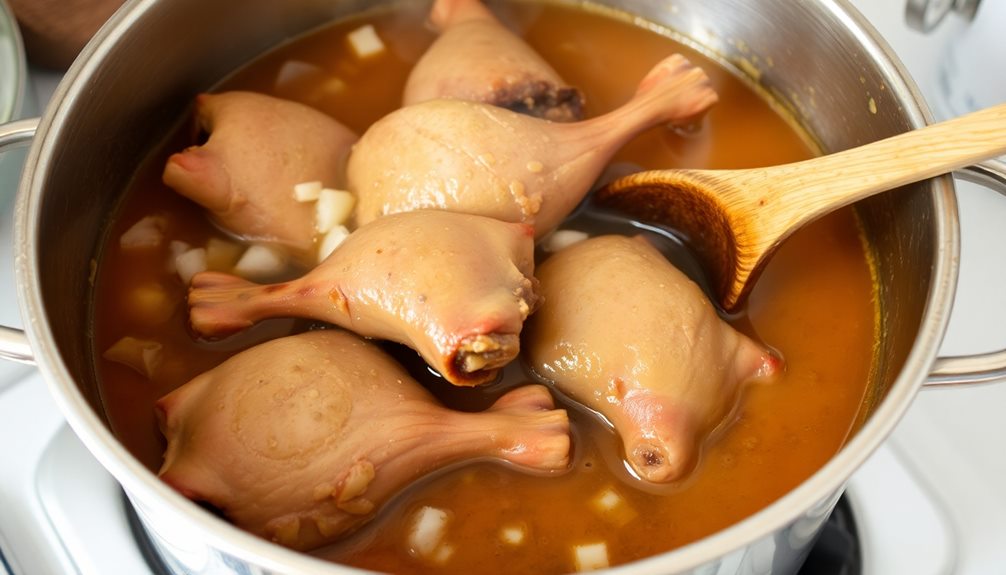
To begin the cooking process, gather the necessary ingredients and equipment. You'll need a large pot, a wooden spoon, and all the yummy ingredients like pork hocks, dried baby shrimp, fish sauce, sugar, and more.
First, place the pork hocks in the pot and cover them with water. Bring the pot to a boil, then reduce the heat and let it simmer for about 2 hours. This will tenderize the meat and create a flavorful broth.
Next, remove the pork hocks from the pot and let them cool slightly. Once they're cool enough to handle, use your hands to shred the meat into small pieces.
Return the shredded pork to the broth and stir in the dried baby shrimp, fish sauce, sugar, and a pinch of salt. Bring the mixture back to a boil, then reduce the heat and let it simmer for 45 minutes to 1 hour, stirring occasionally, until the flavors meld and the broth thickens.
Step 1. Soak Gelatin in Cold Water

Gelatin's power lies in its capacity to transform liquids into firm, jiggly textures. To unleash this magical property, you'll start by soaking the gelatin in cold water. This simple step is crucial, as it allows the gelatin to absorb the liquid and "bloom," preparing it for the next stage.
Take the powdered gelatin and sprinkle it evenly over the surface of the cold water. Don't stir or mix it just yet – let it sit for 5 to 10 minutes. During this time, the gelatin will swell and soften, creating a gelatinous network that will later trap the flavors of your dish.
Once the gelatin has bloomed, you can gently stir it to fully incorporate it into the water. At this point, it's ready to be added to your warm pork broth, where it will melt and seamlessly blend, creating the signature jellied texture of this Vietnamese delicacy.
Step 2. Strain Gelatin, Discard Soaking Water

After the gelatin has bloomed, strain it through a fine-mesh sieve, discarding the soaking water. This step is crucial to remove any impurities or undissolved bits of gelatin.
Simply place the sieve over a bowl and carefully pour the gelatin mixture through, letting the clear liquid pass through while the gelatin strands remain in the sieve.
Once strained, you'll be left with pure, high-quality gelatin ready to use in your Vietnamese Jellied Pork recipe.
This step ensures your final dish will have a smooth, silky texture without any unwanted lumps or grittiness.
With the gelatin properly prepared, you can now move on to the next stage of the recipe, where you'll combine it with the savory pork broth to create the perfect jellylike consistency.
Get ready for a true taste of Vietnamese culinary tradition!
Step 3. Combine Soaked Gelatin With Broth
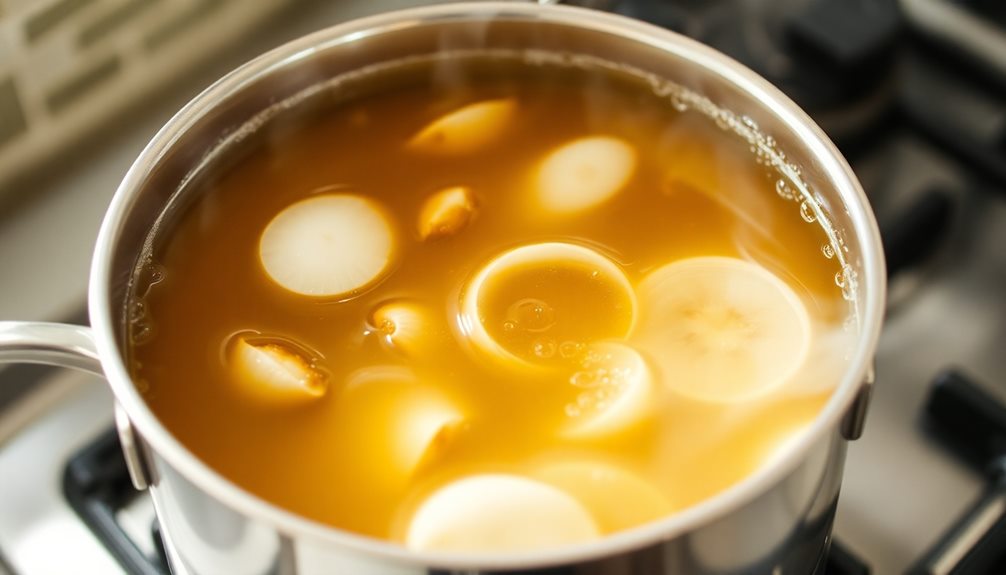
With the gelatin now strained, you can combine it with the savory pork broth. Gently pour the bloomed gelatin into the warm broth, stirring constantly to ensure it's fully incorporated. The gelatin will gradually melt, thickening the broth and creating a luscious, gelatinous texture.
Once the gelatin has fully dissolved, give the mixture a taste. Adjust the seasoning as needed, adding a pinch of salt or a splash of fish sauce to balance the flavors. You want the broth to be well-seasoned, as it will form the base of your jellied pork.
Carefully pour the gelatin-enriched broth into your prepared mold or container. Cover the surface with plastic wrap to prevent a skin from forming, then refrigerate the mixture until it's completely set, about 4 to 6 hours or overnight.
This chilling process is crucial, as it allows the gelatin to firm up and the flavors to meld together.
Step 4. Chill Broth Mixture Until Set
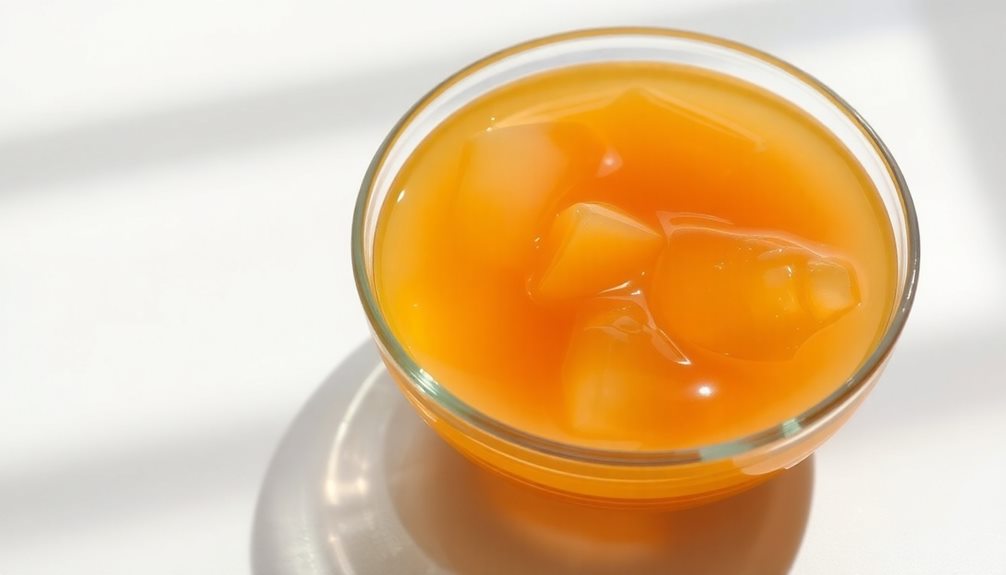
Once the gelatin has dissolved into the savory pork broth, you'll need to chill the mixture until it's fully set. This is a crucial step in creating the perfect Vietnamese jellied pork dish.
You'll want to pour the broth into a shallow pan or baking dish, making sure it's no more than 1-2 inches deep. This will help the mixture cool and set evenly. Be sure to cover the pan with plastic wrap or a lid to prevent a skin from forming on top.
Now, you'll need to pop the pan in the fridge and let it chill for at least 4 hours, or until the broth has completely solidified. You might even want to leave it overnight to ensure it's nice and firm.
Once it's set, you can remove the pan from the fridge and give it a gentle shake to check if it's ready. If it jiggles like a wobbly gel, then you know it's time to move on to the next step in this delicious Vietnamese recipe.
Step 5. Slice and Serve Chilled Gelatin
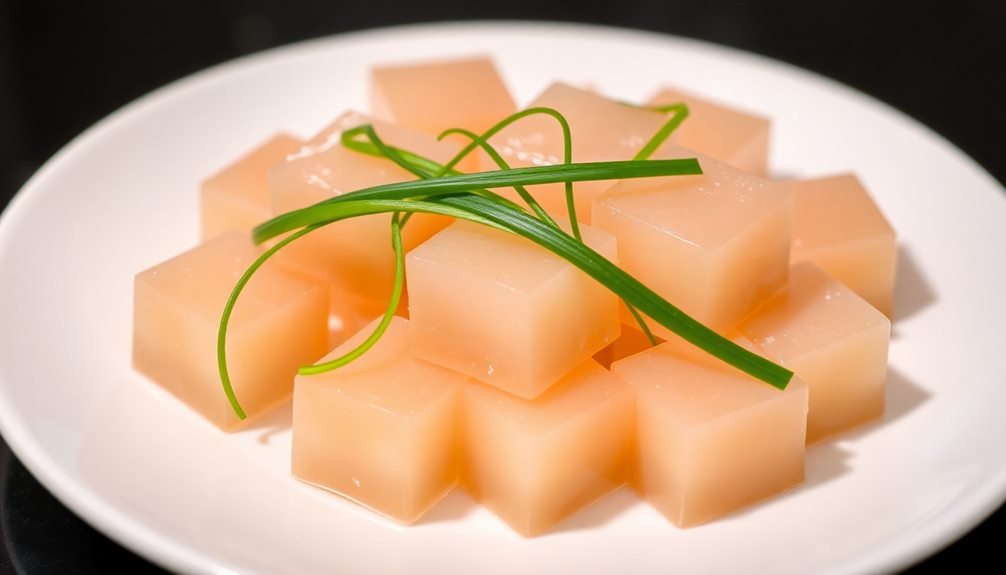
When the gelatin is fully set, carefully remove the pan from the fridge. The chilled pork mixture should have a firm, jelly-like texture.
Grab a sharp knife and gently slice the gelatin into neat, uniform pieces. Be gentle to avoid cracking the delicate slices. Arrange the slices on a serving plate or platter, letting them chill further in the fridge until ready to serve.
Now it's time to enjoy your handiwork! Take the plate out of the fridge and set it on the table. The translucent, wobbly slices are a beautiful sight, reflecting the light and catching the eye.
Invite your guests to spoon the gelatin onto their plates, perhaps offering a drizzle of the reserved broth or a sprinkle of fresh herbs on top. The cool, savory-sweet flavor and smooth, silky texture will delight everyone's taste buds.
Don't be surprised if your family and friends can't stop raving about this traditional Vietnamese delicacy!
Final Thoughts
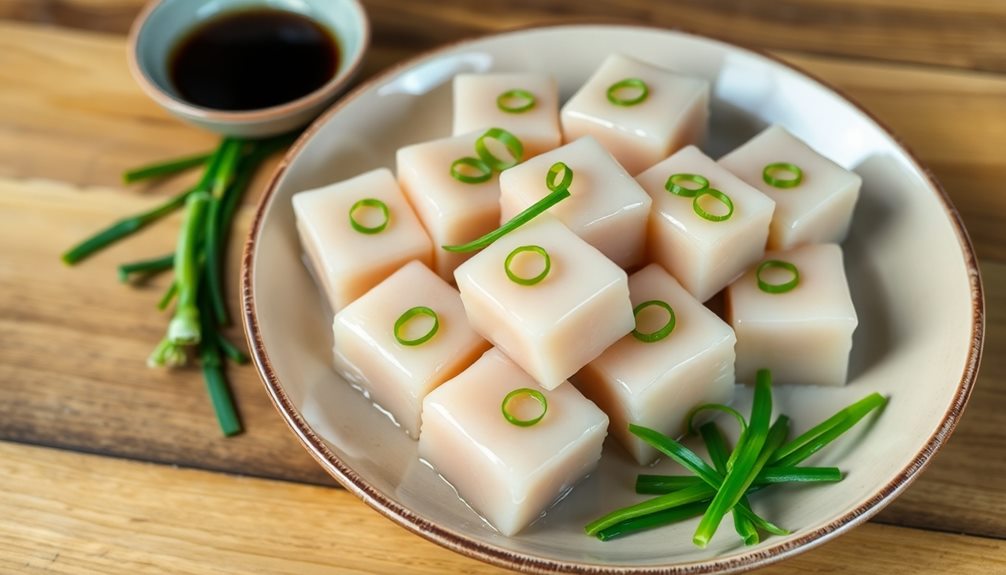
In savoring the rich flavors of Vietnamese Jellied Pork, you'll be struck by the deft balance of textures and the delightful interplay of salty, sweet, and savory elements.
This traditional dish is a true celebration of Vietnamese culinary artistry, with each component meticulously prepared to create a harmonious whole. The firm, gelatinous pork exterior gives way to the tender, succulent meat within, while the crunchy peanuts and aromatic herbs provide a refreshing contrast. The addition of fish sauce and caramelized sugar imparts a deep, savory sweetness that enhances the already rich flavors. To complete the experience, the dish is often served with steamed rice, allowing diners to fully appreciate the intricate balance of textures and tastes. Vietnamese braised pork belly, in particular, exemplifies these qualities, offering a tender, melt-in-your-mouth experience that leaves a lasting impression on any palate.
As you take your first bite, you'll be transported to the bustling streets of Hanoi or the serene countryside, where this beloved dish has been a cherished part of festive gatherings for generations.
The perfect accompaniment to a festive meal, Vietnamese Jellied Pork is a testament to the ingenuity and culinary prowess of the Vietnamese people.
Dive in and savor every delightful morsel, for this is a taste of Vietnam's vibrant cultural heritage.
Frequently Asked Questions
What Are the Health Benefits of Thit Dong?
While the health benefits of thit dong may be limited, it can be a tasty and culturally significant dish when enjoyed in moderation. It provides protein, though it's also high in fat and sodium, so you'll want to balance it with other nutritious foods.
How Long Does Thit Dong Keep in the Refrigerator?
Properly stored in the refrigerator, thit dong can keep for up to a week. Make sure to keep it well-sealed to maintain freshness. After that, it's best to consume or freeze the leftovers.
Can Thit Dong Be Frozen for Later Use?
Yes, you can freeze thit dong for later use. Simply place the jellied pork in an airtight container or wrap it tightly in plastic before freezing. It'll keep for several months when frozen properly.
What Are Some Alternative Serving Suggestions for Thit Dong?
You can serve thit dong in a variety of ways beyond the traditional festive occasions. Try it sliced and served with rice, in soup, or as a savory appetizer. Get creative and explore different flavor combinations.
Is Thit Dong Suitable for Vegetarians or Vegans?
No, thit dong is not suitable for vegetarians or vegans. It's a meat-based dish made with pork, so it doesn't align with plant-based diets. You'll need to find alternative Vietnamese dishes that cater to your dietary preferences.
